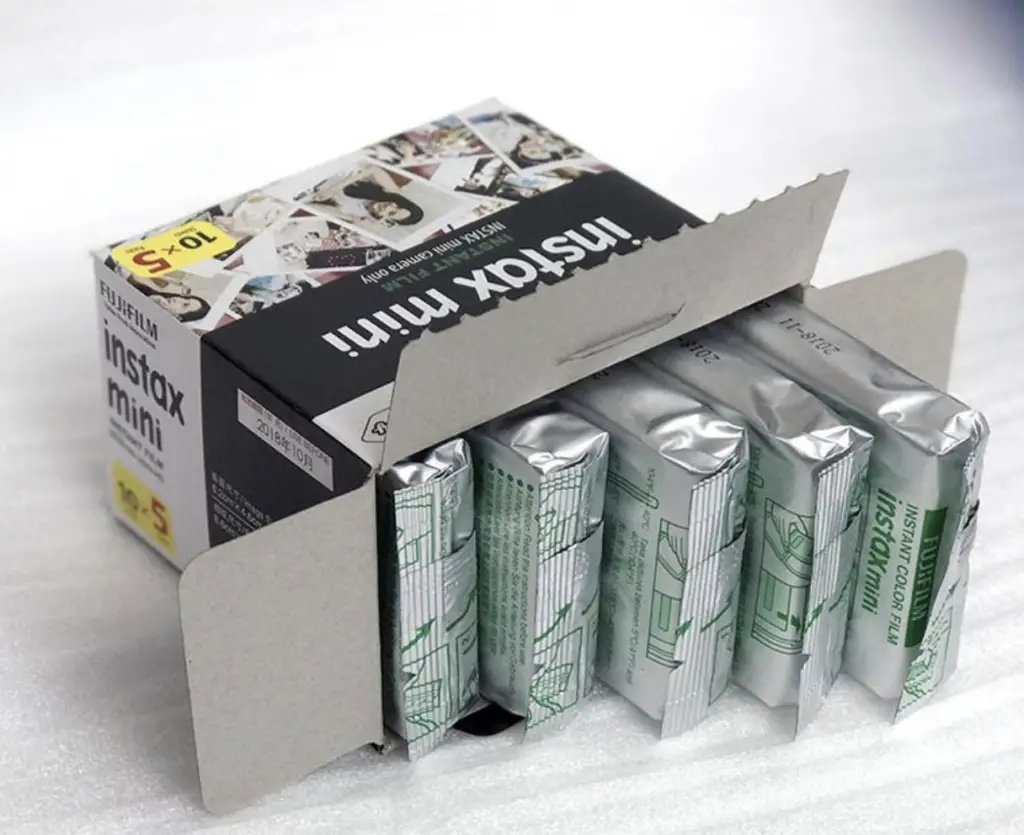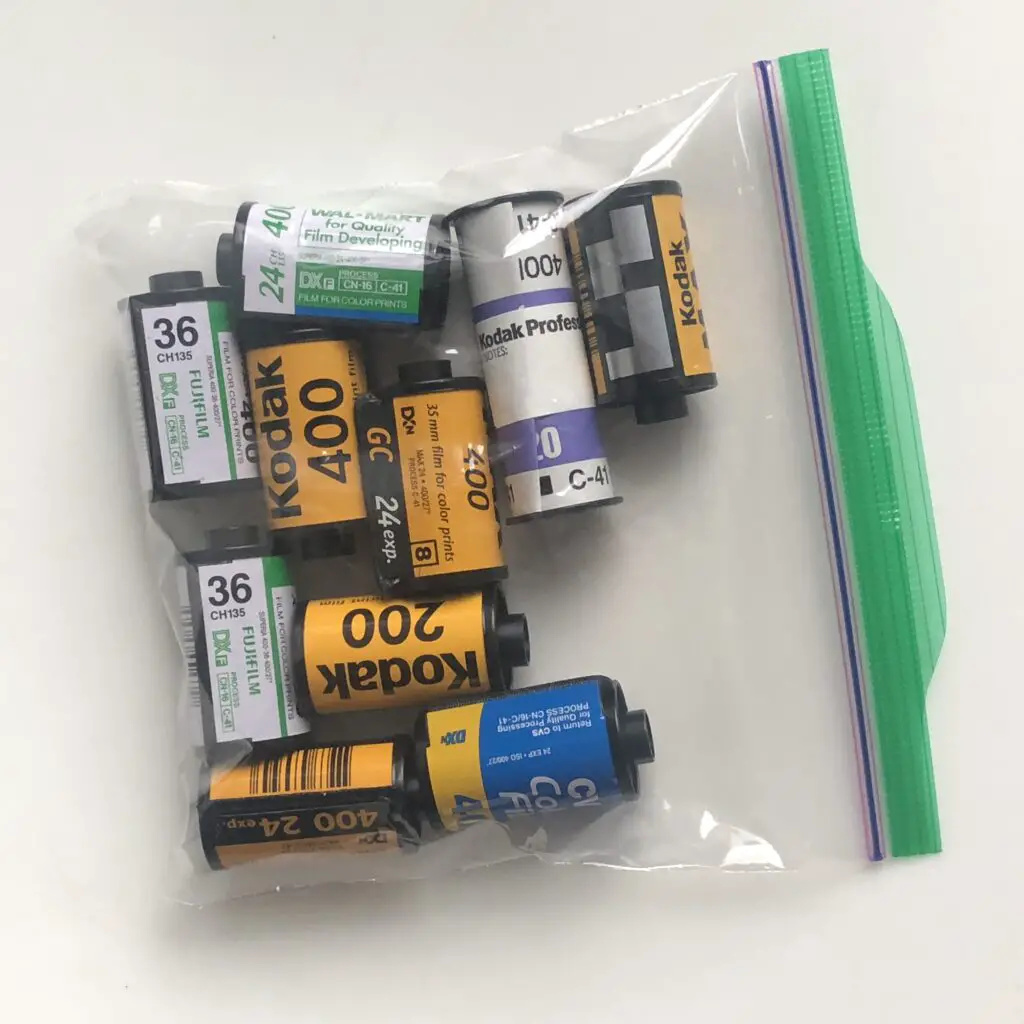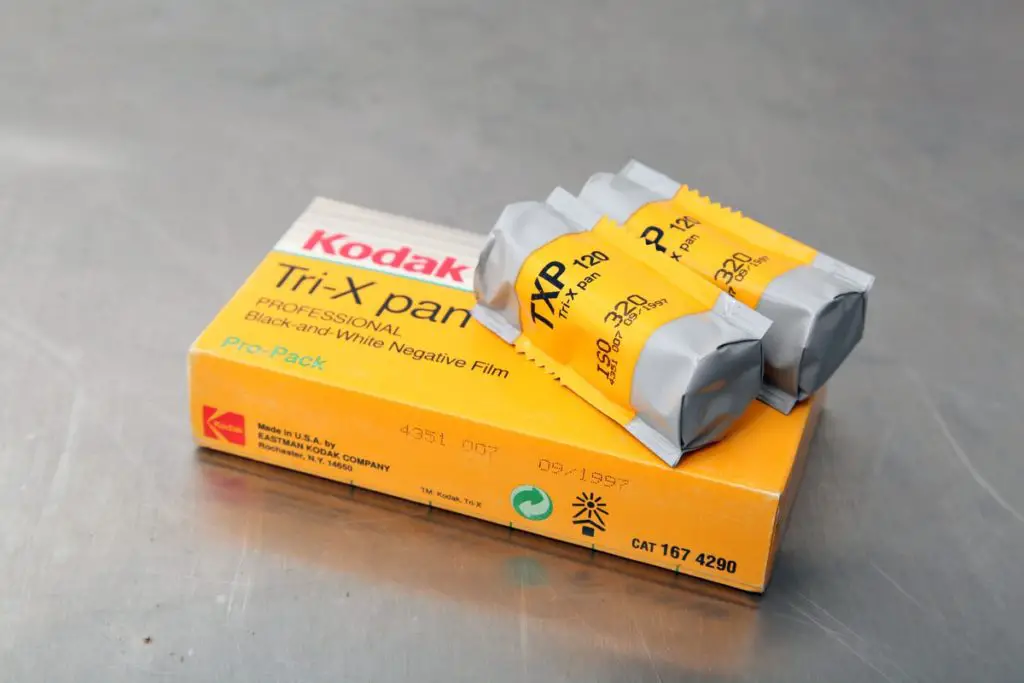If you’re a passionate film photographer, there’s no doubt you will want to store your film in the best way possible. How, where, why to store film is a much discussed topic among photographers. One of the places you read a lot about storing film is in the refrigerator and/or the freezer but which film should be kept in the refrigerator or freezer and why?
Unexposed 35mm, medium format (120) or instant film can be stored in the refrigerator in their packaging for less than 6 months to stay fresh before using it. Only 35mm or medium format (120) film should be stored in the freezer for long term storage for longer than 6 months in their packaging (up to 10+ years). Instant film should never be kept in the freezer since it will ruin the development chemicals in the film.
Not all film should be stored in both the fridge or the freezer. Read on for tips on how to store different kinds of film and whether it is better to store it in the fridge or the freezer, and how to properly warm the film back up after storing in the the refrigerator or freezer.
Prograde Film vs Consumer Grade Film
The general best practice for storing film is to keep it in it’s packaging, keep it cool, out of direct sunlight, and in an environment with low relative-humidity. Most films like black & white film or consumer grade color film, along with disposable cameras, should be stored in place with low humidity (less than 60% relative humidity), out of direct sunlight, and kept below 70 F / 21 C but this does not necessarily need to be the refrigerator or freezer unless you plan on storing your film for longer than 6 months or longer than the expiration date.
However, it is recommended to store professional color film (like Kodak Portra in 35mm or 120, Kodak Ektar 100 slide film, or Fujifilm Pro 400H 120 film) at temperatures at or below 55 F (or 13 C) in the refrigerator or freezer in their original packaging to have consistent performance from the film.
NOTE: Be sure to check on film stored in the fridge or freezer to make sure mold or mildew doesn’t grow on the packaging or labels.
35mm Film
Where Should I Store 35mm Film?
Storing professional grade 35mm film is straightforward. Store your unexposed rolls of 35mm film in a cool, dark, and dry environment, preferably in their original container. You can safely store them in a fridge for short-term storage (less than 6 months) and in the freezer for long-term storage (more than 6 months).
If your film is exposed, store it in the film canister and develop it as soon as possible for best results. Store your exposed film in the fridge (around 55 F or 13 C) for 2-3 days to prolong its life and retain the best image quality.
Should I Keep 35mm Film in the Fridge?
It is highly recommended to store 35mm film in the fridge. Cold temperatures are optimal for storing 35mm film, especially color film. In addition, fridges provide low humidity and a cool environment to preserve the quality of your film. This applies to both unexposed and exposed films and is more necessary for color film.
When storing your 35mm film in the fridge or freezer, always keep your film in a sealed container, which can be its original canister or box, foil bag, or Ziplock bag to fight against mold or mildew.
How Long Can I Store My 35mm Film?
How long you store your 35mm film depends on whether it is black & white or color film. Color film can be stored in a cool environment for up to six months. Black & white film can be stored at room temperature (around 70 F or 21 C) until its expiration date.
You can store color and black & white film in the refrigerator for up to 6 months or until their expiration date. For a longer storage, freeze your film for 12 months or more! Be sure to check on your film periodically to make sure there is no mold or mildew on the packaging, which can happen while storing in the fridge or freezer.
Can I Store Black & White 35mm Film In The Fridge?
Yes, black and white 35mm film can be stored in the fridge but it isn’t as necessary to retain the image quality as color film because black-and-white films can be stored for short periods of time at temperatures up to 24°C (75°F).
However, if the film is unexposed, it will only last until its expiration date. For the exposed film, you can store it in the fridge for 2-3 days before development to retain the image quality.
Can I Store 35mm Color Film in the Fridge?
Yes, storing your unexposed color film in the fridge is essential to retain the film’s quality but it also depends if you are using consumer or professional level film.
With Kodak Professional color films (like Kodak Portra 400), Kodak suggests storing film under refrigeration at 55 F (13 C) to avoid image deterioration. However, with Kodak consumer films and disposable cameras, they say you can store them at temperatures up to 70 F (21 C).
to avoid image deterioration. However, with Kodak consumer films and disposable cameras, they say you can store them at temperatures up to 70 F (21 C).
To learn more about storing exposed film, see this article.
Should I Store 35mm Slide Film in the Fridge?
Store unexposed slide film in the refrigerator or freezer at 55 F (or 13 C) in its original packaging. Once the film is used, it should be processed as soon as possible for best results but can be stored in the fridge for 2 – 3 days before anything happens to the captured image on the film.
Note: To avoid moisture condensation on film that has been refrigerated, allow the film to warm up to room temperature before opening the package.
Can I Store 35mm Film In The Freezer?
Storing your 35mm film in the freezer is an excellent way to keep bulk amounts of film fresh and preserve its ability to retain an image. Freezing is only suitable for long-term storage (longer than 6 months) and should not be used for a short-term solution. This preservation method is only suitable for the unexposed film; freezing exposed film will damage the images and result in low-quality images.
When storing your 35mm film in the fridge or freezer, always keep your film in a sealed container, which can be its original canister or box, foil bag, or Ziplock bag to fight against mold or mildew.
NOTE: Take care when defrosting your frozen film; ensure it reaches room temperature before loading it into your camera, which will take between 2 – 5 hours with good air circulation between film rolls depending on your film type and how it was stored.
Disposable Cameras

Where Do You Store Disposable Cameras?
Disposable cameras can be stored at temperatures up to 70 F / 21 C without losing image quality and out of direct sunlight and humidity higher than 60%. Disposable cameras stored in the fridge or freezer should be placed in an airtight bag like a ziplock bag, and is only recommended if you live in a highly humid and/or hot environment.
To learn more about storing exposed film, see this article.
Can I Store My Disposable Camera In The Freezer?
If you have bought a bulk number of disposable cameras, you can keep them in the freezer for long-term storage for up to 12 months. This is excellent for preserving disposable cameras past their expiration date.
Always put your disposable camera in a airtight bag, like a ziplock bag, before putting it into the fridge or freezer, to limit the damage to the metal and electronic parts in the camera. Also remember to thoroughly defrost your camera to room temperature (for 2 to 5 hours) before shooting photographs so there is no condensation on your film when you use it.
Should I Store Black & White, Or Color Disposable Cameras in a Fridge or Freezer?
Both black and white and color disposable cameras can be stored in the fridge or freezer to retain image quality. It is recommended to store your disposable camera in a cool (around 70 F / 21 C or less) and dry environment (less than 60% humidity). It is best to use your disposable camera before the expiration date and develop it quickly.
However, you can keep your disposable cameras in a cold environment to retain the film’s freshness, which applies to both black and white and color cameras. If you keep your disposable camera in the fridge or freezer, first place them in a airtight bag, like a ziplock bag, to limit complications with the metal and/or electronics in the camera and store them in the fridge short-term (less than 6 months) and the freezer long-term (more than 6 months).
Medium Format or 120 Film
Where Should I Keep My Medium Format (120) Film?
Medium format film should be stored with the same principles as 35mm film. Keep it in a cold, dry, and dark environment.
When storing your medium format (120) film in the fridge or freezer, always keep your film in a sealed container, which can be its original canister or box, foil bag, or Ziplock bag to fight against mold or mildew.
To learn more about storing exposed film, see this article.
Should You Keep Medium Format (120) Film In A Fridge?
Storing medium format film in the fridge is advised as it provides a cool environment that preserves your film—store unexposed film for up to 6 months in your fridge or until its expiration date. You can also store exposed medium film for a few days before developing.
Can I Store Medium Format Film In The freezer?
Store your medium format film in the freezer for long-term storage. This is incredibly useful when working with a lot of film and buying bulk. In addition, you can keep the film past its expiration date by freezing it to preserve the quality. Also, be sure to check on your film periodically to make sure there is no mold or mildew on the packaging, which can happen while storing in the fridge or freezer.
Should I Store Black And White Or Color Medium Format In A Fridge?
Black and white medium format film can be stored at room temperature, around 70 F / 21 C, as long as it is in out of direct sunlight and in an low humidity environment (less than 60%). Therefore, storing black & white medium film in the fridge is not essential.
However, storing your color medium format film in the fridge is essential to preserve the film quality. Color medium film deteriorates rapidly in warm temperatures and will not last at room temperature.
Instant Film

Does Polaroid Film Need To Be Refrigerated?
Yes, polaroid recommends that all instant film needs to be stored unopened, sealed package and in a cool and dry environment, such as a refrigerator, in a constant temp of between 41 – 65 F (4 – 18 C).
that all instant film needs to be stored unopened, sealed package and in a cool and dry environment, such as a refrigerator, in a constant temp of between 41 – 65 F (4 – 18 C).
To learn more about storing exposed film, see this article.
Can You Freeze Polaroid film?
It recommended to never freeze Instax film. Doing so damages the chemistry stored in pods that are built into the film itself, and your film will not develop properly when used. Therefore, it is essential that you keep it cool but never frozen.
Should I Put Instax Film In The Fridge?
Keeping Instax film in the fridge is the best way to store your film. Instax film thrives in cool and dry environments, and keeping it in the fridge will retain the vivid color and keep the chemistry intact for crisp, high-quality images when used. However, don’t forget to thaw the film before use by setting it out a couple hours beforehand.
Can Instant Film Be Stored In The Freezer?
instant film should never be stored in the freezer. Freezing instant film packs damages the chemicals stored in the film itself that allows for the film to function; freezing deactivates these chemicals and will ruin your print. For high-quality, instant print images, make sure to use room temperature film that has been stored in the fridge.
How Do I Warm Up Film After Freezing or Refrigeration?
Make sure to warm up your unexposed film when you remove it from the fridge or freezer before shooting it to avoid condensation on the film ruining your film. To do this:
- Remove your film from the fridge or freezer.
- Break up bulk stored film so there is good air circulation but keep film in original packaging, film canister, or foil pouch
- Let film sit on a table to warm up to room temperature (70 F or 21 C) before using. You can also touch your film in it’s packaging to check on it’s progress of warming up.
- Load your film into your camera as you normally would
Kodak recommends letting your film sit between 1 – 3 hours before shooting your film after storing in the freezer. See how long to let your film sit based on storage temperature and size of film in the chart shown below:
Size of Film | Hours of Warm-Up Time to Reach Room Temperature ( 70 F or 21 C) From a Storage Temperature of 55 F (13 C) |
|---|---|
120 film roll | 0.75 |
35mm film roll | 1.25 |
long 35mm film roll (longer than 36 exposures) | 3 |
10 sheets film box | 1 |
50 sheet film box | 2 |
In Summary
The golden rule for storing film is to keep your film cool, out of direct sunlight, and dry. Always keep your film in a sealed container, which can be its original canister or box, foil bag, or an airtight container like a ziplock bag when placing it the fridge or freezer. Store your unexposed disposable camera, 35mm, 120 film, or instant film in the fridge for short-term storage (more than 6 months) to preserve the film quality. For long-term storage you should store your film in the freezer where the unexposed film can be stored for up to 15 years in the freezer. Exposed 35mm or 120 film, keep it in the fridge to preserve your images before development.
Disposable cameras can be stored in a cool environment up to 70 F / 21 C , out of direct sunlight, and in an environment with a relative humidity lower than 60% to avoid losing image quality. Disposable cameras can also be stored in the fridge or freezer but first they should be placed in an airtight bag, like a Ziplock bag, to limit problems with the electronics.
Instant film can be stored in the fridge before shooting but should never be stored in the freezer since it will ruin the chemical pods built into the film.
Sources:
- https://thedarkroom.com/tips-for-storing-photography-film/

- https://imaging.kodakalaris.com/sites/default/files/wysiwyg/pro/cis_e30.pdf




